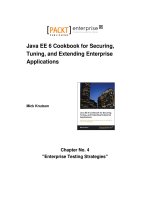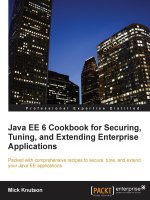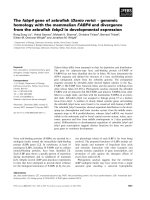Java EE 8 cookbook build reliable applications with the most robust and mature technology for enterprise development
Bạn đang xem bản rút gọn của tài liệu. Xem và tải ngay bản đầy đủ của tài liệu tại đây (11.11 MB, 624 trang )
Java EE 8 Cookbook
Build reliable applications with the most robust and mature
technology for enterprise development
Elder Moraes
BIRMINGHAM - MUMBAI
Java EE 8 Cookbook
Copyright © 2018 Packt Publishing
All rights reserved. No part of this book may be reproduced, stored in a retrieval system, or
transmitted in any form or by any means, without the prior written permission of the
publisher, except in the case of brief quotations embedded in critical articles or reviews.
Every effort has been made in the preparation of this book to ensure the accuracy of the
information presented. However, the information contained in this book is sold without
warranty, either express or implied. Neither the author, nor Packt Publishing or its dealers
and distributors, will be held liable for any damages caused or alleged to have been caused
directly or indirectly by this book.
Packt Publishing has endeavored to provide trademark information about all of the
companies and products mentioned in this book by the appropriate use of capitals.
However, Packt Publishing cannot guarantee the accuracy of this information.
Commissioning Editor: Merint Mathew
Acquisition Editor: Isha Raval
Content Development Editor: Jason Pereira
Technical Editor: Prajakta Mhatre
Copy Editor: Safis Editing
Project Coordinator: Sheejal Shah
Proofreader: Safis Editing
Indexer: Mariammal Chettiyar
Production Coordinator: Deepika Naik
First published: April 2018
Production reference: 1060418
Published by Packt Publishing Ltd.
Livery Place
35 Livery Street
Birmingham
B3 2PB, UK.
ISBN 978-1-78829-303-7
www.packtpub.com
To Jesus Christ, my only source of eternal life and purpose.
To my beloved wife, Erica—thanks for your love and for sharing your life with me.
To my adorable daughter, Rebeca—if this book helps a single person, maybe it could help
turning the world a better place for you.
To the memory of my mother, Matilde, who I miss every day.
To my brother, Marco, who introduced me to this incredible world of computers and
software.
To my friend and guru, Bruno "Javaman" Souza—I would probably never have written
this book if I hadn't meet you.
To the amazing team at SouJava—you folks really live the community thing.
To my peers at TCDB for all encouragement, tips, sharing, and feedbacks. Thank you!
– Elder Moraes
mapt.io
Mapt is an online digital library that gives you full access to over
5,000 books and videos, as well as industry leading tools to help
you plan your personal development and advance your career. For
more information, please visit our website.
Why subscribe?
Spend less time learning and more time coding with practical
eBooks and Videos from over 4,000 industry professionals
Improve your learning with Skill Plans built especially for you
Get a free eBook or video every month
Mapt is fully searchable
Copy and paste, print, and bookmark content
PacktPub.com
Did you know that Packt offers eBook versions of every book
published, with PDF and ePub files available? You can upgrade to
the eBook version at www.PacktPub.com and as a print book customer,
you are entitled to a discount on the eBook copy. Get in touch with
us at for more details.
At www.PacktPub.com, you can also read a collection of free technical
articles, sign up for a range of free newsletters, and receive
exclusive discounts and offers on Packt books and eBooks.
Foreword
It is a measure of the penetration, longevity, and quality of Java
EE technology that in 2018 my friend Elder Moraes asked me to
write the foreword for his book about Java EE 8. My personal
involvement with Java EE goes back to the days preceding J2EE 1.4
in 2001. Since then, I have had the great honor of leading or coleading the community teams that have developed JavaServer
Faces and, later, servlet, two of the technologies Elder covers in
this book. During that time, I tried to follow the model of servantleader, and I think the result has been a very engaged community
that has a real stake in the continued success of Java EE.
When writing this foreword, I want to focus on four Cs:
Curation, Cohesion, Current, and Completeness. So much has been
written about Java EE over the years, and continues to be written,
that the task of writing a book, particularly one in the useful
"cookbook" format, involves a lot of curation. From the set of all
possible things that people are doing with Java EE, which is
vast, Elder has presented a curation of what he thinks are the most
useful and essential ones. Elder is well positioned to decide what
goes in and what stays out. Elder has been consulting and working
with Java EE for nearly as long as I have, but from the more
practical perspective of the user.
Technical books that follow the cookbook pattern frequently suffer
from a feeling of disjointness. Not this book. Elder has put a great
deal of effort into ensuring cohesion. Over the years, the
technologies of Java EE have sometimes been criticized for not
being cohesive enough with each other. This is
something Sun made a conscious effort to address starting with
Java EE 6, and which Oracle continued on to Java EE 8. Elder has
leveraged this effort to seek out and present the best way to
leverage the synergy of all the technologies of Java EE 8
to maximum effect.
The world outside Java EE has continued to evolve, and this has
changed the way people use Java EE dramatically. The challenge
for any architect on a multiyear software effort, with a service
lifetime of at least a decade, is how to keep it maintainable even
while the surrounding technology landscape changes. Elder has
accounted for this with two excellent chapters about microservices
and Docker. These two technologies provide a great complement to
the power of Java EE, but also have numerous pitfalls. Elder helps
you avoid the pitfalls while getting the most out of these current
trends.
Finally, completeness. Many technology cookbooks stop short
of providing "complete reference" sort of material, but Elder goes
much deeper. It's almost to the point that the term "cookbook"
does not do this book justice. Perhaps, a more correct label would
be "complete restaurant management with supply chain logistics
and a cookbook on top." Elder covers the current popular app
servers on which people are running Java EE, continuous
integration and pipelines, reactive programming, and more.
Coming back to the curation point, it's all there, and in depth.
I hope you have success with Java EE and with its successor,
Jakarta EE from the Eclipse Foundation.
Ed Burns
Consulting Member of Technical Staff at Oracle
Specification Lead of JSF and Servlet
Contributors
What this book covers
, New Features and Improvements, explains the main
changes to the Java EE 8 specification and what the reader can do
with them. It also shows the new features and briefly explores the
benefits of them. All these topics are supported by code examples.
Chapter 1
, Server-Side Development, deep dives into the most
important APIs and most commonly used features for server-side
development. The readers here will go through real recipes for
solving real problems.
Chapter 2
, Building Powerful Services with JSON and RESTful
Features, creates web services for different enterprise scenarios.
Readers will go deep into the JAX-RS, JSON-P, and JSON-B APIs.
Chapter 3
, Web- and Client-Server Communication, deals with the
communication generated by web applications in a fast and reliable
way using the latest Java EE 8 features, such as HTTP2 and Server
Push.
Chapter 4
, Security of Enterprise Architecture, gives the readers
information on the tools using the best Java EE features to create
secure architectures.
Chapter 5
, Reducing the Coding Effort by Relying on Standards,
describes the services and features that Java EE application servers
give to the applications they host. Those features not only let the
readers rely on a standard and build their application based on it,
but also allow them to write less code, as they don't need to
implement features that have been already implemented by the
server.
Chapter 6
, Deploying and Managing Applications on Major Java EE
Servers, describes the use of each of the most commonly used Java
EE application servers on the market, giving special attention to
the way you deploy and manage them.
Chapter 7
, Building Lightweight Solutions Using Microservices,
makes you understand how microservice architectures work and
how readers can easily use Java EE 8 to build microservice and/or
break down their monoliths in order to implement this paradigm.
Chapter 8
Continuous Delivery and Continuous Deployment are also
described, as no successful microservice project is complete
without a mature building and deployment process.
, Using Multithreading on Enterprise Context, describes the
use of multithreading and concurrency when building enterprise
applications.
Chapter 9
, Using Event-Driven Programming to Build Reactive
Applications, describes the use of Java EE 8 and core Java to create
low-latency, efficient, and high-throughput applications.
Chapter 10
, Rising to the Cloud – Java EE, Containers, and Cloud
Computing, describes how to combine Java EE and containers to
run applications on the cloud.
Chapter 11
, The Power of Sharing Knowledge, describes how the
community is vital for the whole Java EE ecosystem (even if
readers don't know about it) and how they can improve their own
daily work by joining the Adopt a JSR initiative.
Appendix
It also describes how sharing knowledge is a powerful tool for
improving their careers and what it has to do with Java EE (and it
has everything to do with Java EE!).
About the author
Elder Moraes helps Java EE developers build and deliver secure,
fast, and available applications so that they are able to work on
great projects. He is passionate about content sharing; he does it by
speaking at international events, blogging, and writing articles.
He has been working with Java since 2002 and has developed
applications for different industries. As a board member at
SouJava, he led the Java EE 8 - The Next
Frontier initiative, interviewing some of the world class Java EE
experts.
First, I have to thank my wife and daughter, Erica and Rebeca, respectively, for all the
time they allowed me to put into writing this book. It was not easy for any of us. Also,
thank you to my friends, Lucas and Mari, for all the support and encouragement since
day one. Last but not least, thank you to all the Packt team (Isha, Sreeja, Jason, Prajakta,
and others that I haven't talked personally). You folks rock!
About the reviewers
Romain Manni Bucau is a senior software engineer who has
been involved in Java EE and more particularly Apache projects as
a committer (Apache TomEE, OpenWebBeans, Johnzon, BatchEE,
OpenJPA, BVal, Meecrowave, and many more) since 2011. He also
wrote JavaEE 8 High Performance for Packt. He now works at
Talend on Big Data and API projects.
You can follow him on Twitter at @rmannibucau or on his blog at
rmannibucau.metawerx.net.
Omar El-Prince is an experienced software engineer with a
computer engineering graduate degree and master's degree in
computer science from Johns Hopkins University. He has wide
experience on working in large Java EE projects at CSRA, Booz
Allen Hamilton, HP, EDS, and other companies. He enjoys
programming and technology blogging, focused on agile culture,
software development, and architecture. He is Java EE enthusiastic
and loves learning, mentoring, and helping others.
Bauke Scholtz is an Oracle Java champion and the main creator
of the award-winning JSF helper library OmniFaces. On the
internet, he is more commonly known as BalusC, who is among the
top contributors on Stack Overflow. He is a web application
specialist and consults for clients from fintech, affiliate marketing,
social media, and more as part of his 17 years of experience. Bauke
has previously reviewed Mastering OmniFaces and wrote The
Definitive Guide to JSF in Java EE 8.
Packt is searching for
authors like you
If you're interested in becoming an author for Packt, please visit aut
hors.packtpub.com and apply today. We have worked with thousands of
developers and tech professionals, just like you, to help them share
their insight with the global tech community. You can make a
general application, apply for a specific hot topic that we are
recruiting an author for, or submit your own idea.
Table of Contents
Title Page
Copyright and Credits
Java EE 8 Cookbook
Dedication
Packt Upsell
Why subscribe?
PacktPub.com
Foreword
Contributors
About the author
About the reviewers
Packt is searching for authors like you
Preface
Who this book is for
What this book covers
To get the most out of this book
Download the example code files
Conventions used
Sections
Getting ready
How to do it...
How it works...
There's more…
See also
Get in touch
Reviews
1.
New Features and Improvements
Running your first Bean Validation 2.0 code
Getting ready
How to do it...
How it works...
See also
Running your first CDI 2.0 code
Getting ready
How to do it...
How it works...
There's more...
See also
Running your first JAX-RS 2.1 code
Getting ready
How to do it...
How it works...
See also
Running your first JSF 2.3 code
Getting ready
How to do it...
How it works...
There's more...
See also
Running your first JSON-P 1.1 code
Getting ready
How to do it...
How it works...
See also
Running your first JSON-B code
Getting ready
How to do it...
How it works...
See also
Running your first Servlet 4.0 code
Getting ready
How to do it...
How it works...
There's more...
See also
Running your first Security API code
Getting ready
How to do it...
How it works...
There's more...
See also
Running your first MVC 1.0 code
Getting ready
How to do it...
How it works...
See also
2.
Server-Side Development
Using CDI to inject context and dependency
Getting ready
How to do it...
How it works...
There's more...
See also
Using Bean Validation for data validation
Getting ready
How to do it...
How it works...
See also
Using servlet for request and response management
Getting ready
How to do it...
How it works...
There's more...
See also
Using Server Push to make objects available beforehand
Getting ready
How to do it...
How it works...
There's more...
See also
Using EJB and JTA for transaction management
Getting ready
How to do it...
How it works...
There's more...
See also
Using EJB to deal with concurrency
Getting ready
How to do it...
How it works...
There's more...
See also
Using JPA for smart data persistence
Getting ready
How to do it...
How it works...
See also
Using EJB and JPA for data caching
Getting ready
How to do it...
How it works...
There's more...
See also
Using batch processing
Getting ready
How to do it...
How it works...
See also
3.
Building Powerful Services with JSON and RESTful Features
Building server-side events with JAX-RS
Getting ready
How to do it...
How it works...
There's more...
See also
Improving service's capabilities with JAX-RS and CDI
Getting ready
How to do it...
How it works...
There's more...
See also
Easing data and objects representation with JSON-B
Getting ready
How to do it...
How it works...
See also
Parsing, generating, transforming, and querying on JSON objects using JSON
-P
Getting ready
How to do it...
How it works...
See also
4.
Web- and Client-Server Communication
Using servlets for request and response management
Getting ready
How to do it...
The load on startup servlet
A servlet with init params
The asynchronous servlet
How it works...
The load on startup servlet
A servlet with init params
Asynchronous servlet
See also
Building UI with template's features using JSF
Getting ready
How to do it...
How it works...
See also
Improving the response performance with Server Push
Getting ready
How to do it...
How it works...
There's more...
See also
5.
Security of Enterprise Architecture
Introduction
Domain protection with authentication
Getting ready
How to do it
How it works...
See also
Granting rights through authorization
Getting ready
How to do it...
How it works...
See also
Protecting data confidentiality and integrity with SSL/TLS
Getting ready
How to do it...
How it works...
There's more...
See also
Using declarative security
Getting ready
How to do it...
How it works...
See also
Using programmatic security
Getting ready
How to do it...
How it works...
See also
6.
Reducing the Coding Effort by Relying on Standards
Introduction
Preparing your application to use a connection pool
Getting ready
How to do it...
There's more...
See also
Using messaging services for asynchronous communication
Getting ready
How to do it...
How it works...
See also
Understanding a servlet's life cycle
Getting ready
How to do it...
How it works...
See also
Transaction management
Getting ready
How to do it...
How it works...
See also
7.
Deploying and Managing Applications on Major Java EE Servers
Introduction
Apache TomEE usage
Getting ready
How to do it...
Deploying EAR, WAR, and JAR files
Creating datasources and a connection pool
Logging setup and rotate
Starting and stopping
Session clustering
There's more...
See also
GlassFish usage
Getting ready
How to do it...
Deploying EAR, WAR, and JAR files
Creating datasources and a connection pool
Logging setup and rotate
Starting and stopping
Session clustering
There's more...
See also
WildFly usage
Getting ready
How to do it...
Deploying EAR, WAR, and JAR files
Creating datasources and a connection pool
Logging setup and rotate
Starting and stopping
Session clustering
There's more...
See also
8.
Building Lightweight Solutions Using Microservices
Introduction
Building microservices from a monolith
Getting ready
How to do it...
Building a monolith
Building microservices from the monolith
The user microservice
The user address microservice
The gateway microservice
How it works...
The monolith
The microservices
There's more...
See also
Building decoupled services
Getting ready
How to do it...
How it works...
See also
Building an automated pipeline for microservices
Getting ready
Preparing the application
Preparing the environment
How to do it...
Continuous integration
Git
Maven
JUnit
Continuous delivery
Continuous deployment
There's more...
See also
9.
Using Multithreading on Enterprise Context
Introduction
Building asynchronous tasks with returning results
Getting ready
How to do it...
How it works...
See also
Using transactions with asynchronous tasks
Getting ready
How to do it...
How it works...
See also
Checking the status of asynchronous tasks
Getting ready
How to do it...
How it works...
See also
Building managed threads with returning results
Getting ready
How to do it...
How it works...
See also
Scheduling asynchronous tasks with returning results
Getting ready
How to do it...
How it works...
See also
Using injected proxies for asynchronous tasks
Getting ready
How to do it...
How it works...
See also
10.
Using Event-Driven Programming to Build Reactive Applications
Introduction
Building reactive applications using asynchronous servlets
Getting ready
How to do it...
How it works...
See also
Building reactive applications using events and observers
Getting ready
How to do it...
How it works...
See also
Building reactive applications using websockets
Getting ready
How to do it...
How it works...
See also
Building reactive applications using message-driven beans
Getting ready
How to do it...
How it works...
See also
Building reactive applications using JAX-RS
Getting ready
How to do it...
How it works...
See also
Building reactive applications using asynchronous session beans
Getting ready
How to do it...
How it works...
See also
Using lambdas and CompletableFuture to improve reactive applications
Getting ready
How to do it...
How it works...
See also
11.
Rising to the Cloud – Java EE, Containers, and Cloud Computing
Introduction
Building Java EE containers using Docker
Getting ready
How to do it...
How it works...
See also
Using Oracle Cloud for container orchestration in the cloud
Getting ready
How to do it...
How it works...
There's more...
Using Jelastic for container orchestration in the cloud
Getting ready









